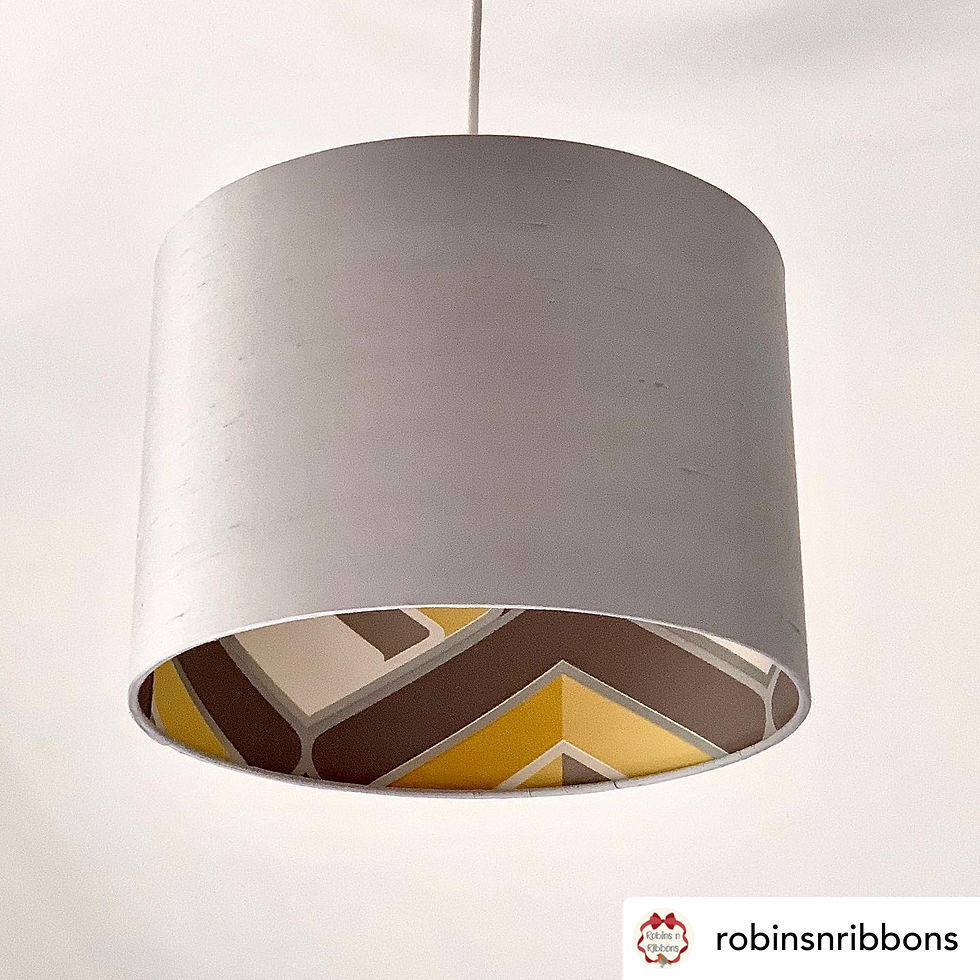Seeing Double - Double-Sided Lampshade Making
- Dannells Admin
- Apr 12, 2023
- 4 min read
Make your handmade lampshade work twice as hard by ensuring it's not only beautiful on the outside, but on the inside too! Our Double Sided Lampshade Making PVC has been designed specifically to showcase your favourite fabrics and papers to the max and in today’s blog post, we’ll explore the materials you need to make a double-sided lampshade, how to make them, along with tips and tricks from our lampshade makers.

What exactly is a double-sided lampshade?
It’s a lampshade that features fabric or paper, most commonly wallpaper, on both the inside and outside of the shade.
What materials can you use to make a double-sided lampshade?
The best fabrics for lampshade making are woven fabrics (stretch fabrics don’t adhere to the self-adhesive panels properly) that range from light to medium weight. Any fabric that's too thick or bulky will create a problem in the final tucking stages of making your lampshade.
Most popular with our Lampshade Makers are combinations of fabric outers with fabric inners, fabric outers and paper inners, but there is nothing stopping you from using any combination of fabric and paper.

What do I need to consider when picking my fabrics or papers?
With a double-sided lampshade the light will shine through the inner material first, therefore if you choose, say, a patterned wallpaper for the inner shade and a plain, light-coloured outer fabric for the outer, you may see the inner wallpaper through Double-Sided Lampshade Making PVC, creating what’s known as a ‘silhouette lampshade’. If this isn’t the effect you are looking for, it’s best to choose a darker or thicker fabric on the outside. Along the same lines, a darker outer shade material will work best with a lighter inner shade material.
When using wallpaper that has a horizontal pattern for the inside of your shade, you'll need to pattern match two pieces of wallpaper, similar to how you would when wallpapering a wall. Read our blog post – Making a Wallpaper Lampshade and follow the same principles for adding wallpaper to your inner shade.

Which lampshade shapes can be made as double-sided?
Our Double-Sided Self-Adhesive panels are available for drum lampshades, but can also be for oval lampshades, but we advise buying a longer panel than required for your oval frames and cutting the panel down to size.
Due to the 400-micron thickness of the Double-Sided Self-Adhesive panels, these are not recommended for use with our other geometric-shaped frames, as the panel is too thick to bend around the corners in these shapes.

What do lampshade making materials do I need to make a double-sided lampshade?
Firstly, you’ll need to choose the diameter of the shade you want to make, picking the corresponding Lampshade Ringets. Our Double-Sided lampshade panels allow you to make lampshades ranging from 20cm to a whopping 70cm in diameter.
Each Double-Sided Self-Adhesive Panel is pre-cut to the exact measurements for your chosen frame with panels up to 35cm in diameter measuring 21cm in depth and anything larger (up to 70cm in diameter) measuring 25cm in depth.

In addition, you’ll need a roll of Self-Adhesive PVC Strip size, to create your kisscut at the top and bottom of your panel, creating exactly the right fabric margin for tucking under the rings.
From Dannells.com
Lampshade ring set in your chosen size
Corresponding Double-Sided Self-Adhesive Panel
Additional tools
Scissors for cutting tape

How do I make up my double-sided lampshade?
If you've already made a lampshade from one of our Lampshade Making Kits, the essential difference between this and making a double-sided lampshade is that you apply your inner fabric first, then after cutting round adhere your outer fabric to the remaining side, adding the Self Adhesive PVC strip to create a kisscut, before cutting around.
Our YouTube Video below explains step by step how to make a double-sided lampshade:
Any tips for double-sided lampshade making?
A hot topic on our Lampshade Makers Facebook Group, many makers suggest shortening the length of the fabric by around 0.5cm at each short end to avoid any bulk or visible fabric at the seam when the lampshade is rolled and the seam sealed.

Carole Anne of Yorkshire Shades also offers this advice when using fabric on the inside:
‘Try tucking outer fabric first and keep the edge of inner fabric folded away from the edge of liner then tuck this last’. This ensures that the outer fabric had the room it needs to tuck under.'

Working with directional fabrics or papers? Make sure you note which way your inner fabric is sitting before adding your outer fabric to match the direction.

If you are working with a fabric that frays easily such as linen, using Fray Stop stop along the edges can prevent this!

If you'd like to add a detailed edging to the inside seam why not use a bias binding strip as @poppyroselighting has done in the image below or a strip of Self Adhesive Textile Tape

#doublesidedlampshades #fabricandpapershades #wallpaperlampshades #DIYshade #creativeshades #doublesidedlampshadepanels #lampshademaking #lampshademakingkits #designyourownfabric #uniquelampshadedesign #DIYlampshade #lampshadeknowhow #professionalshades #shademaking #uniquelampshadedesign #lampshade #makerscommunity #lampshadedesigner #lampshademaker #handmadeshade #tipsandtricks #lampshadeknowhow #professionallampshademaking
(small).jpg)


Comments